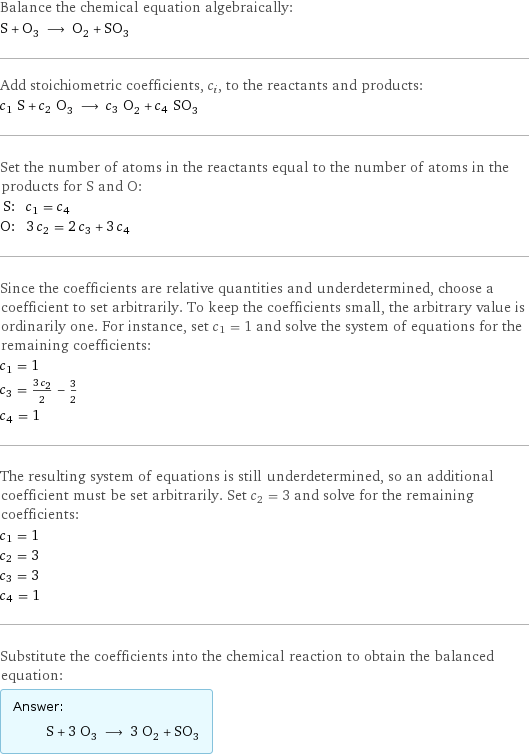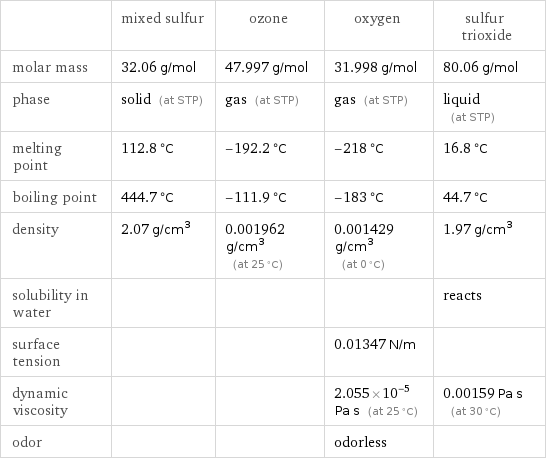Input interpretation

S mixed sulfur + O_3 ozone ⟶ O_2 oxygen + SO_3 sulfur trioxide
Balanced equation

Balance the chemical equation algebraically: S + O_3 ⟶ O_2 + SO_3 Add stoichiometric coefficients, c_i, to the reactants and products: c_1 S + c_2 O_3 ⟶ c_3 O_2 + c_4 SO_3 Set the number of atoms in the reactants equal to the number of atoms in the products for S and O: S: | c_1 = c_4 O: | 3 c_2 = 2 c_3 + 3 c_4 Since the coefficients are relative quantities and underdetermined, choose a coefficient to set arbitrarily. To keep the coefficients small, the arbitrary value is ordinarily one. For instance, set c_1 = 1 and solve the system of equations for the remaining coefficients: c_1 = 1 c_3 = (3 c_2)/2 - 3/2 c_4 = 1 The resulting system of equations is still underdetermined, so an additional coefficient must be set arbitrarily. Set c_2 = 3 and solve for the remaining coefficients: c_1 = 1 c_2 = 3 c_3 = 3 c_4 = 1 Substitute the coefficients into the chemical reaction to obtain the balanced equation: Answer: | | S + 3 O_3 ⟶ 3 O_2 + SO_3
Structures

+ ⟶ +
Names

mixed sulfur + ozone ⟶ oxygen + sulfur trioxide
Equilibrium constant
![Construct the equilibrium constant, K, expression for: S + O_3 ⟶ O_2 + SO_3 Plan: • Balance the chemical equation. • Determine the stoichiometric numbers. • Assemble the activity expression for each chemical species. • Use the activity expressions to build the equilibrium constant expression. Write the balanced chemical equation: S + 3 O_3 ⟶ 3 O_2 + SO_3 Assign stoichiometric numbers, ν_i, using the stoichiometric coefficients, c_i, from the balanced chemical equation in the following manner: ν_i = -c_i for reactants and ν_i = c_i for products: chemical species | c_i | ν_i S | 1 | -1 O_3 | 3 | -3 O_2 | 3 | 3 SO_3 | 1 | 1 Assemble the activity expressions accounting for the state of matter and ν_i: chemical species | c_i | ν_i | activity expression S | 1 | -1 | ([S])^(-1) O_3 | 3 | -3 | ([O3])^(-3) O_2 | 3 | 3 | ([O2])^3 SO_3 | 1 | 1 | [SO3] The equilibrium constant symbol in the concentration basis is: K_c Mulitply the activity expressions to arrive at the K_c expression: Answer: | | K_c = ([S])^(-1) ([O3])^(-3) ([O2])^3 [SO3] = (([O2])^3 [SO3])/([S] ([O3])^3)](../image_source/de27a0f0115dd3b49b65fe0953f3372e.png)
Construct the equilibrium constant, K, expression for: S + O_3 ⟶ O_2 + SO_3 Plan: • Balance the chemical equation. • Determine the stoichiometric numbers. • Assemble the activity expression for each chemical species. • Use the activity expressions to build the equilibrium constant expression. Write the balanced chemical equation: S + 3 O_3 ⟶ 3 O_2 + SO_3 Assign stoichiometric numbers, ν_i, using the stoichiometric coefficients, c_i, from the balanced chemical equation in the following manner: ν_i = -c_i for reactants and ν_i = c_i for products: chemical species | c_i | ν_i S | 1 | -1 O_3 | 3 | -3 O_2 | 3 | 3 SO_3 | 1 | 1 Assemble the activity expressions accounting for the state of matter and ν_i: chemical species | c_i | ν_i | activity expression S | 1 | -1 | ([S])^(-1) O_3 | 3 | -3 | ([O3])^(-3) O_2 | 3 | 3 | ([O2])^3 SO_3 | 1 | 1 | [SO3] The equilibrium constant symbol in the concentration basis is: K_c Mulitply the activity expressions to arrive at the K_c expression: Answer: | | K_c = ([S])^(-1) ([O3])^(-3) ([O2])^3 [SO3] = (([O2])^3 [SO3])/([S] ([O3])^3)
Rate of reaction
![Construct the rate of reaction expression for: S + O_3 ⟶ O_2 + SO_3 Plan: • Balance the chemical equation. • Determine the stoichiometric numbers. • Assemble the rate term for each chemical species. • Write the rate of reaction expression. Write the balanced chemical equation: S + 3 O_3 ⟶ 3 O_2 + SO_3 Assign stoichiometric numbers, ν_i, using the stoichiometric coefficients, c_i, from the balanced chemical equation in the following manner: ν_i = -c_i for reactants and ν_i = c_i for products: chemical species | c_i | ν_i S | 1 | -1 O_3 | 3 | -3 O_2 | 3 | 3 SO_3 | 1 | 1 The rate term for each chemical species, B_i, is 1/ν_i(Δ[B_i])/(Δt) where [B_i] is the amount concentration and t is time: chemical species | c_i | ν_i | rate term S | 1 | -1 | -(Δ[S])/(Δt) O_3 | 3 | -3 | -1/3 (Δ[O3])/(Δt) O_2 | 3 | 3 | 1/3 (Δ[O2])/(Δt) SO_3 | 1 | 1 | (Δ[SO3])/(Δt) (for infinitesimal rate of change, replace Δ with d) Set the rate terms equal to each other to arrive at the rate expression: Answer: | | rate = -(Δ[S])/(Δt) = -1/3 (Δ[O3])/(Δt) = 1/3 (Δ[O2])/(Δt) = (Δ[SO3])/(Δt) (assuming constant volume and no accumulation of intermediates or side products)](../image_source/a0c45a85ac4249a8a4588e689e9a4ab2.png)
Construct the rate of reaction expression for: S + O_3 ⟶ O_2 + SO_3 Plan: • Balance the chemical equation. • Determine the stoichiometric numbers. • Assemble the rate term for each chemical species. • Write the rate of reaction expression. Write the balanced chemical equation: S + 3 O_3 ⟶ 3 O_2 + SO_3 Assign stoichiometric numbers, ν_i, using the stoichiometric coefficients, c_i, from the balanced chemical equation in the following manner: ν_i = -c_i for reactants and ν_i = c_i for products: chemical species | c_i | ν_i S | 1 | -1 O_3 | 3 | -3 O_2 | 3 | 3 SO_3 | 1 | 1 The rate term for each chemical species, B_i, is 1/ν_i(Δ[B_i])/(Δt) where [B_i] is the amount concentration and t is time: chemical species | c_i | ν_i | rate term S | 1 | -1 | -(Δ[S])/(Δt) O_3 | 3 | -3 | -1/3 (Δ[O3])/(Δt) O_2 | 3 | 3 | 1/3 (Δ[O2])/(Δt) SO_3 | 1 | 1 | (Δ[SO3])/(Δt) (for infinitesimal rate of change, replace Δ with d) Set the rate terms equal to each other to arrive at the rate expression: Answer: | | rate = -(Δ[S])/(Δt) = -1/3 (Δ[O3])/(Δt) = 1/3 (Δ[O2])/(Δt) = (Δ[SO3])/(Δt) (assuming constant volume and no accumulation of intermediates or side products)
Chemical names and formulas

| mixed sulfur | ozone | oxygen | sulfur trioxide formula | S | O_3 | O_2 | SO_3 Hill formula | S | O_3 | O_2 | O_3S name | mixed sulfur | ozone | oxygen | sulfur trioxide IUPAC name | sulfur | ozone | molecular oxygen | sulfur trioxide
Substance properties

| mixed sulfur | ozone | oxygen | sulfur trioxide molar mass | 32.06 g/mol | 47.997 g/mol | 31.998 g/mol | 80.06 g/mol phase | solid (at STP) | gas (at STP) | gas (at STP) | liquid (at STP) melting point | 112.8 °C | -192.2 °C | -218 °C | 16.8 °C boiling point | 444.7 °C | -111.9 °C | -183 °C | 44.7 °C density | 2.07 g/cm^3 | 0.001962 g/cm^3 (at 25 °C) | 0.001429 g/cm^3 (at 0 °C) | 1.97 g/cm^3 solubility in water | | | | reacts surface tension | | | 0.01347 N/m | dynamic viscosity | | | 2.055×10^-5 Pa s (at 25 °C) | 0.00159 Pa s (at 30 °C) odor | | | odorless |
Units
